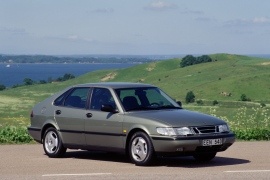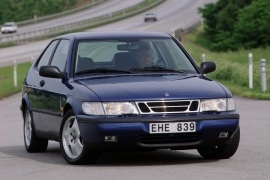SAAB 900 Models/Series Timeline, Specifications & Photos
First production year: 1994
Engines: Gasoline
Body style: Coupé (two-door)
The 900 was more known as a coupe or a convertible, but the Swedish carmaker also made it a four-door sedan.
In 1994, Saab was already under GM's roof and had to comply with the new management rules. Yet, the Swedish engineers were too stubborn to accept the changes, and they still made the cars in their own way. General Motors told them to use the GM2900 platform and build a successor for the 900, and that's what Saab did, but only after it improved the car to a level that only a small part of the vehicle shared its components with its GM siblings, such as the Opel/Vauxhall Vectra.
At the front, the 900 featured Saab's specific grille with chromed trims on the grille and horizontal, rectangular headlights with corner-mounted turn signals. Its wrapped-around bumper sported a set of fog lights on the outer area and a grille in the middle. The mid-size Swedish vehicle showed the specific Saab profile in sedan shape, with a sloped rear end in a Kammback design.
Inside, the cabin was designed around the driver. It kept the Saab-specific features such as the key-fob between the front seats and the tall instrument cluster extended over the center stack. The front bucket seats provided good side support thanks to their bolstered areas. In the back, a split-folding bench could accommodate three people. As for the trunk was a class leader and provided between 602 liters (21.2 cu-ft) and up to 1,600 liters (56.5 cu-ft) with the rear seats folded.
Under the hood, Saab installed a choice of three inline-four engines developed by the Swedish brand and a 2.5-liter V-6 carried over from General Motors. The carmaker offered a unique option for the transmission, named Sensonic. It was, in short, a manual gearbox with an electronically controlled clutch, which was needed only when starting but not while driving.
Saab introduced the last generation of the 900 in 1994 and offered it in various shapes and sizes, including a coupe, but it was short-lived.
Saab was not a great asset in terms of profitability for its owner, which was General Motors. But it was a brand with a great heritage and was seen on the European market as a premium brand. GM struggled to get into that segment, and Opel couldn't do that. So, in 1994, Saab introduced a successor for the aging 900 series that was introduced in 1978. It was based on the same platform as the first generation of the Opel Vectra.
The aerodynamic look of the car had something with the carmaker's heritage in the aircraft industry. That led to a slim front fascia with a grille that resembled an aircraft with its two side intakes for the engines. For the coupe version, the 900 featured an ascending beltline ending in a raked-forward C-pillar and no rear deck. At the back, the taillights were visually linked together with a red plastic mold that crossed the tailgate from side to side.
Inside the cabin, Saab installed a pair of bucket seats at the front with high-bolstered areas that kept their occupants in place during high-speed cornering. In the back, the bench was fit for two, although the carmaker suggested that it was wide enough for three.
Under the hood, Saab installed a choice of three inline-four engines developed by the Swedish brand and a 2.5-liter V-6 carried over from General Motors. The carmaker offered a unique option for the transmission, named Sensonic. It was, in short, a manual gearbox with an electronically controlled clutch, which was needed only when starting but not while driving.

